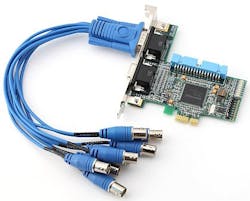PCI-Express eight-channel frame grabber for fast image capture introduced by Sensoray
TIGARD, Ore. 24 Oct. 2012. Sensoray in Tiegard, Ore., is introducing model 812 PCI-Express eight-channel frame grabber with eight asynchronous input channels and a high-speed PCI-Express x1 interface that acts as a complete hardware solution for applications such as high-performance image capture, multi-camera security applications, and for product inspection.
Each video channel captures at frame rate of 30 frames per second (FPS) (for NTSC) or 25 FPS (for PAL), which results in an aggregate frame rate of as many as 240 FPS (for NTSC) or 200 FPS (for PAL). Eight channels of mono audio can be captured as well.
The board implements a PCI-Express x1 interface for plug-and-play operation into any width of PCI-Express slots, company officials say. All operating power comes from the PCI-Express bus and no external power supply is necessary.
Captured video data can stream continuously to system memory or disk for immediate local display or further processing. All eight composite video inputs are connected through a DB15 connector, or through an optional DB15-to-BNC breakout cable.
An additional 34-pin connector can break-in the all composite video input signals. Video capture resolutions include D1, VGA, QVGA, CIF, 4CIF, SIF, and 4SIF.
Captured frames can be in YUYV, YUV420, or RGB555/RGB565 formats. Similarly, DB15 connector and in-one 34-pin connector are provided for audio inputs. The audio sampling rate can be at 8,000, 16,000, 32,000, 44.1,000, or 48,000 Hz.
Sensoray provides an SDK for the model 812 that includes drivers and programming samples for both Windows and Linux operating systems. For more information contact Sensoray online at www.sensoray.com.
Follow Military & Aerospace Electronics and Avionics Intelligence news updates on Twitter

